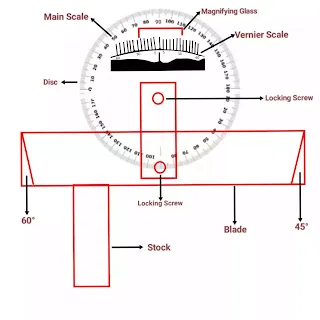Hello friends, Today we are going to discuss Vernier bevel protractor in which we will know parts of vernier bevel protractor, how to calculate least count of vernier bevel protractor, and at the last also know how to read Vernier bevel protractor.
Vernier bevel protractor is an angle measuring micrometers used to layout or check
an angle of up to 5 minutes precision.
Its design consists of a fixed stock and an adjustable blade
with a graduated dial.
Graduations are made from 0 ° to 90 ° or 0 ° to 180 °.
It can be rotated at any angle around
a circle and clamped to a certain position by a locking Screw nut.
So, without wasting time let's know all aspects related to the Vernier bevel protractor.
Definition of Vernier Bevel Protractor
Vernier bevel protractor is used to measure the angle of any job or workpiece.This allows an angle of up to 5 minutes accuracy.
Parts of Vernier Bevel Protractor
There are the following parts of the Vernier bevel protractor:- Stock
- Blade
- Disc
- Main Scale
- Dial
- Vernier Scale
- Locking Screw
- Magnifying Glass
 |
| Parts of Vernier Bevel Protractor |
Stock
In measuring the angle, it is one of the contact
surfaces.It would be better if it is placed in contact with the surface of the job being measured along with the angle to be measured.
Blade
This is the second contact surface of the Vernier bevel protractor which comes in contact with the measured surface of the job while measuring.It is found in the range of 150 mm to 300 mm.
One end of the blade is 45° and the other end is 60°.
Disc
It is the most important part of the vernier bevel protractor it has a main scale which is divided into 360 equal parts.Each division is equal to 1°.
Main Scale
It is divided into 360 equal parts, and they are made in the graduation of 0° to 90° or 0° to 180°.Dial
It is located in the center of the disc which can be rotated up to 360° and also the Vernier scale is inscribed in it.Vernier Scale
The Vernier scale consists of 12 lines to the right of the 0 lines and 12 lines to the left.Each line is equal to 5 minutes.
12 parts of the Vernier scale are equal to 23 parts of the main scale.
Locking Screw
It has two locking screws, one of which is used to lock the dial and the other to lock the blade.Magnifying Glass
A magnifying glass is used to clearly read the measurements.How to Calculate Least Count of Vernier Bevel Protractor?
As we know,12 divisions of vernier scale are equal to 23° or 23 divisions of the main scale.
So,
1 division of vernier scale = 23°/12
1 division of vernier scale = 1.916°
Since,
1° = 60 minutes
Hence,
1 division of vernier scale = 1.916 × 60
1 division of Vernier scale = 115 minutes.
Now,
Least Count Formula of Vernier Bevel Protractor = (Value of two main scale divisions - Value of Vernier scale division)
So,
Least Count of Vernier Bevel Protractor = 2° - 1.916°
After converting in minutes then,
Least Count of Vernier Bevel Protractor = 120 - 115 = 5
So,
Least Count of Vernier Bevel Protractor = 5 min
Now we can say that the Least Count of Vernier Bevel Protractor is 5 minutes.
How to Read Vernier Bevel Protractor?
There are the following methods that should be applied during reading vernier bevel protractor:1. Firstly attached the surface of the job with the help of stock and blade.
2. Then see and write which line of the main scale is matching with the 0 lines of the vernier scale.
3. Then see which line of the Vernier scale matches with the line of the main scale in the forwarding direction.
4. And then multiply by 5 whatever readings you get.
5. After that added both reading and which value is obtained is vernier bevel protractor reading.
For example,
So,
Main Scale Reading = 80°
Then clearly see in the figure vernier scales 7th no. line matching with the main scale line.
Then it's multiplied by 5 because each line of the vernier scale is equal to 5 minutes.
So,
Vernier Scale Reading = 7 × 5 = 35 min.
After adding both values the final reading was obtained.
Vernier Bevel Protractor Reading = 80° + 35min
Vernier Bevel Protractor Reading = 80+(35/60)
Vernier Bevel Protractor Reading = 80.58°
Care and Maintenance of Vernier Bevel Protractor
1. Always clean the Vernier bevel protractor before use.2. After use, it should be kept in a safe place with a thin coating of oil.
So here I discussed parts of vernier bevel protractor, how to calculate the least count of vernier bevel protractor, and also know how to read Vernier bevel protractor.
I hope you all enjoy this topic.
FAQ Related to Vernier Bevel Protractor
What is the accuracy of bevel protractor?
The accuracy of Vernier bevel protractor is 5 minutes.What is the least count of Vernier bevel protractor?
The least count of the bevel protractors is 5 minutes.What is the use of Vernier bevel protractor?
It is the commonly used for measuring an angle up to accuracy of 5 minutes.What is the formula of Vernier bevel protractor least count?
Vernier bevel protractors least count formula areWhich part of Vernier bevel protractor is attached to disc?
A dial is the part of Vernier bevel protractor which is attached to the disc.Which type of angle can be measure by Vernier bevel protractor?
All types of angle can be measured by it like acute angle, obtuse angle.
On Which principle Vernier bevel protractor work?
It
is based on the difference of two analog scales. In which one is the Vernier
scale and the other is the main scale.




0 Comments